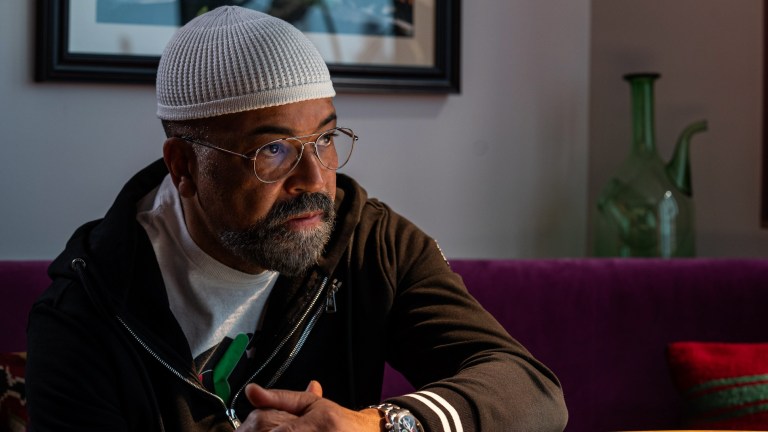How Highest 2 Lowest Finally Brought Jeffrey Wright and Spike Lee Together
Exclusive: Jeffrey Wright opens up about a relationship with Spike Lee that goes back to the ‘80s, as well as how they reimagined an Akira Kurosawa classic in Highest 2 Lowest.

Jeffrey Wright and Spike Lee are only nine years apart in age. They have also known each other since near the beginning of their careers, with the Tony and Emmy-winning actor telling us that he first met Lee when he was still a young thespian on the make in New York City. It was 1989 and Wright had just moved to the five boroughs after growing up in D.C. Yet even back then—and in the same year that Lee would win the Palme d’Or for Do the Right Thing—Spike already loomed large in the popular imagination as a singular chronicler of NYC stories.
“He certainly is on the Mount Rushmore of New York ambassadors,” Wright muses with a smile when we catch up with the Westworld actor. “I remember seeing She’s Gotta Have It, I guess in’86, a couple of years before I moved here, and that was one of the films that was a calling card to the city for me.” Alongside other formative filmmaking giants like Sidney Lumet and Midnight Cowboy’s John Schlesinger, Spike Lee and the New York of his mind’s eye had a habit of creating its own mythology, especially for young creatives like Wright.
“These are films that showed this kind of mysterious, expansive, gritty New York that for an East Coast kid like myself, and for one who was interested in a creative life, were exciting windows into this place,” Wright remembers. “There are many filmmakers who represent New York, but Spike is unique in the way he frames this city. You take in his films visually, but you also feel the tones and you feel the heat or the cold of the city through his lens. He celebrates the city in a unique way, and I don’t think there’s been another filmmaker in the history of the medium who loves New York as passionately as he does.”
Despite having a shared history, and even at one point living in the same Brooklyn neighborhood of Fort Greene—where Lee’s production company 40 Acres and a Mule Filmworks is still located—Lee and Wright were never quite able to get together professionally, unless you count a brief vocal cameo Wright provided to Spike’s Netflix adaptation of She’s Gotta Have It. (“a tiny, tiny bit” Wright laughs.) But it’s not for a lack of trying.
“We’ve been talking about it for years, a long time,” Wright says, noting while they met in ’89, they got to know each other better in subsequent years, including after Wright broke through for originating the role of Belize on Broadway in Tony Kushner’s Angels in America. “We had talked about a couple of projects here and there,” Wright says. But it never came together until he received a call that Lee wanted to meet up at the Brooklyn Museum to discuss a new project: an ambitious reimagining of Akira Kurosawa’s High and Low.
“We finally dove into it with this one,” Wright says. “And although I’ve gotten to know him somewhat, to watch Spike work is, in some ways, to really see who he is. Because he is so passionate about film and about filmmaking, and about New York, and that all weaves together. So it was a real insider thrill to get a chance to be on set with him.”
The fruits of that collaboration, Highest 2 Lowest, opens in theaters today courtesy of A24, and ahead of its Apple TV+ premiere on Sept. 5. The film is a sprawling epic about what it means to be moral and true to one’s core values in our ever increasingly transactional society. Hence the dilemma at the center of the film wherein a record company chief famed for his “golden ears”—and appropriately named David King (Denzel Washington)—is confronted with an insidious king’s ransom. On the same morning that David made the business deal that will define his legacy, he is informed that his teenage son Trey (Aubrey Joseph) has been kidnapped.
In point of fact though, the kidnappers have actually mixed up David’s son with Trey’s best friend Kyle (Elijah Wright), who just so happens to be the son of David’s childhood best friend and now lived-in BFF, driver, and confidant, Paul (Wright). How the world, the NYPD, and social media react to a rich man’s son being kidnapped versus that of a Black man who did a stint upstate is uncomfortably timely. But how it also tests David’s own vision of himself, and how his friends and family see him, becomes the real test.
What’s interesting about the story’s central thrust is that despite being primarily based on a 1963 Japanese film from a master filmmaker, it feels decidedly American in 2025—albeit Wright is quick to point out that Kurosawa’s movie, in turn, is based on an Ed McBain novel from 1959.
“[McBain] was a New York writer,” Wright notes, “so in some ways we’re coming full circle.” Yet the appeal to Wright isn’t necessarily so much how Spike Americanizes the tale, but how he finds an accessibility in the melody, even while drastically changing up the notes.
“I think what’s wonderful about Spike’s reinterpretation of Kurosawa is he framed it in a way, yes, that is culturally specific to contemporary New York and a contemporary America, but I think has larger, more universal, appeal through this moral dilemma and the tensions born of the circumstances.”
This is still a story very much about discerning, as Washington’s King states at one point, the difference between “good money and bad money.” However, it is most assuredly a Spike Lee joint when that common truth is disseminated in a story where the climax occurs on a subway train filled with rowdy New Yorkers on their way to a Red Sox game at Yankee Stadium. There is also a world of difference between how High and Low depicts the relationship between Toshiro Mifune’s troubled captain of industry, Kingo Gondo, and Aoki (Yutaka Sada), Kingo’s chauffeur whose much younger child in the original film is kidnapped.
“The relationship between Mifune’s character in Kurosawa’s High and Low, and the character that my character Paul was based on, his driver,” says Wright, “is a very different one. It’s interesting in the way that it’s born of these Japanese hierarchical caste dynamics. There was such deference and such a level of submissiveness on the part of his driver that is so, for lack of a better word, foreign to what one might expect in the streets of New York—although it’s a big city. But I really appreciate the ways in which the script rethought that relationship.”
In Highest 2 Lowest, Wright’s Paul and Washington’s David are lifelong friends. There is obvious respect and deference paid to the latter given his station—he’s literally called “King” by Paul, but there is no “mister” applied before that, and one can surmise Paul was also calling him that when they were boys. Furthermore, Paul has no issue riding with King into any dangerous situation… or standing up for his son when no one else will.
It’s a complex dynamic that gives Wright a lot to play opposite Washington, a star whom Wright calls “one of the great actors of the cinema, period.” He also notes Washington is “an incredibly generous performer in that he feeds you a lot of stuff to play off. So I just tried to reflect back to him and ideally build this relationship together.”
Yet once again, Highest 2 Lowest seems to partially build off a shared history, including the fact Washington and Wright previously worked together in Jonathan Demme’s 2004 remake of The Manchurian Candidate.
Says Wright: “I think there was just a sense of trust that we built together working on that film and then early on in the process of working on this one, and obviously I have enormous respect for him.” Highest 2 Lowest arguably even seems to invite a meta-textual awareness of everyone’s shared history. After all, at one point in the movie Trey says to the older generation that “it feels like 2004 in here.” And more acutely, this is obviously the fifth (and possibly final) collaboration between Lee and Washington after the two worked on some of the most iconic films of the last 40 years, including Malcolm X (1992) and Mo’ Better Blues (1990). And this fact seems to be echoed in every magazine and photo in David King’s Brooklyn penthouse reflecting Washington’s younger countenance from the ‘90s and 2000s.
“Spike uses these symbols of the success and renown of this character, David King, and in doing so, he’s borrowing on the success of Denzel,” Wright explains. “Denzel has the type of history and stature as a cultural figure that certainly lends itself to the strength of this character that he’s playing, so I think there’s a very clever overlap there that Spike employs.”
But it’s doing the work, both on the set and then in the finished film, that makes Highest 2 Lowest’s place in film history tangible.
“In terms of their work together they are a duo on the top shelf of director-actor partnerships in the history of cinema,” Wright considers, “so that brings a lot of expectation, but it also brings a lot of forcefulness to their collaboration into any project that they’re a part of. The history between the two of them is palpable on set, and the mutual respect and kind of creative love between them just fills every set that we shot on.”
Sometimes experiences are worth the wait.
Highest 2 Lowest is in theaters now and premieres on Apple TV+ on Sept. 5.
